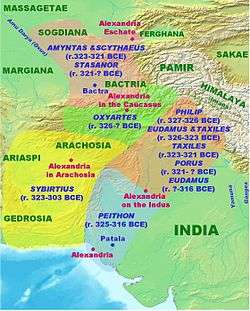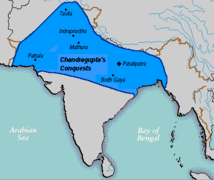Seleucid–Mauryan war
| Seleucid–Mauryan War | |||||||
|---|---|---|---|---|---|---|---|
 Alexander the Great's Satrapies in Northern India. | |||||||
| |||||||
| Belligerents | |||||||
| Maurya Empire | Seleucid Empire | ||||||
| Commanders and leaders | |||||||
| Chanakya | Seleucus I Nicator | ||||||
| Strength | |||||||
|
~600,000 Infantry ~30,000 Cavalry ~9,000 Elephants | ~250,000 Infantry | ||||||
| Casualties and losses | |||||||
The Seleucid–Mauryan War was fought between 305 and 303 BCE. It started due to the occupation of the Indian satrapies of the Macedonian Empire by Emperor Chandragupta Maurya, of the Maurya Empire. Seleucus I Nicator, of the Seleucid Empire, sought to retake those territories.
The war ended in a settlement resulting in the annexation the Indus Valley region and perhaps Afghanistan to the Mauryan Empire, with Chandragupta securing control over the areas that he had sought, and a marriage alliance between the two powers. After the war, the Mauryan Empire emerged as the dominant power of the Indian Subcontinent.
Background

Chandragupta Maurya established himself as ruler of Magadha around 321 BCE. He decided to conquer the Nanda Dynasty, rulers at the time of the Gangetic Plain. He fought the empire for eleven years with successful guerrilla campaigns, and captured the Nanda capital of Pataliputra. This led to the fall of the empire and the eventual creation of the Maurya Empire under Emperor Chandragupta Maurya.
The Persian provinces in what is now modern Afghanistan, together with the wealthy kingdom of Gandhara and the staes of the Indus Valley, had all submitted to Alexander the Great and become part of his empire. When Alexander died, the Wars of the Diadochi ("Successors") split his empire apart; as his generals fought for control of Alexander's empire. In the eastern territories one of these generals, Seleucus I Nicator, was taking control and was starting to establish what became known as the Seleucid Empire. According to the Roman historian Appian, Seleucus,
always lying in wait for the neighboring nations, strong in arms and persuasive in council, he acquired Mesopotamia, Armenia, 'Seleucid' Cappadocia, Persis, Parthia, Bactria, Arabia, Tapouria, Sogdia, Arachosia, Hyrcania, and other adjacent peoples that had been subdued by Alexander, as far as the river Indus, so that the boundaries of his empire were the most extensive in Asia after that of Alexander. The whole region from Phrygia to the Indus was subject to Seleucus.
Alexander had appointed satraps in control of his territories. Similarly satraps were appointed to govern the Indus Valley. The Mauryans had annexed the areas governed by four such satraps: Nicanor, Phillip, Eudamus and Peithon. This established Mauryan control to the banks of the Indus. Chandragupta's victories convinced Seleucus that he needed to secure his eastern flank. Seeking to hold the Macedonian territories there, Seleucus thus came into conflict with the emerging and expanding Mauryan Empire over the Indus Valley.[1] So began the Seleucid-Mauryan War.
War
Details of the conflict are lacking, though Seleucus Nicator ceded the Hindu Kush, Punjab and parts of Afghanistan to Chandragupta Maurya.[2]
Per Appian, Seleucus
crossed the Indus and waged war with Sandrocottus [Maurya], king of the Indians, who dwelt on the banks of that stream, until they came to an understanding with each other and contracted a marriage relationship. Some of these exploits were performed before the death of Antigonus and some afterward.
Consequences
In consequence of their arrangement, Seleucus received 500 war elephants from Chandragupta Maurya, which subsequently influenced the Wars of the Diadochi in the west. With the war elephants acquired from the Mauryas, Seleucus was able to defeat his rival, Antigonos, at the Battle of Ipsus. Adding Antigonos's territories to his own, Seleucus would found the Seleucid Empire, which would endure as a great power in the Mediterranean and the Middle East until 64 BCE.
Chandragupta Maurya went on to expand his rule in India into the Deccan.[2] :
Notes
- ↑ Kosmin 2014, p. 34.
- 1 2 [R.G. Grant: Commanders pg. 49 https://books.google.com/books?id=tFQcwH2StsMC&q=chandragupta#v=snippet&q=chandragupta&f=false]
References
- Kosmin, Paul J. (2014), The Land of the Elephant Kings: Space, Territory, and Ideology in Seleucid Empire, Harvard University Press, ISBN 978-0-674-72882-0
- Majumdar, Ramesh Chandra (2003) [1952], Ancient India, Motilal Banarsidass, ISBN 81-208-0436-8